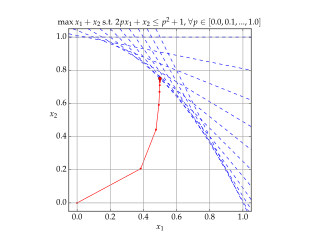In mathematics, the Legendre forms of elliptic integrals are a canonical set of three elliptic integrals to which all others may be reduced. Legendre chose the name elliptic integrals because the second kind gives the arc length of an ellipse of unit semi-major axis and eccentricity .

Interior-point methods are a certain class of algorithms that solve linear and nonlinear convex optimization problems.
In mathematics, the Lanczos approximation is a method for computing the gamma function numerically, published by Cornelius Lanczos in 1964. It is a practical alternative to the more popular Stirling's approximation for calculating the gamma function with fixed precision.

In the context of fast Fourier transform algorithms, a butterfly is a portion of the computation that combines the results of smaller discrete Fourier transforms (DFTs) into a larger DFT, or vice versa. The name "butterfly" comes from the shape of the data-flow diagram in the radix-2 case, as described below. The earliest occurrence in print of the term is thought to be in a 1969 MIT technical report. The same structure can also be found in the Viterbi algorithm, used for finding the most likely sequence of hidden states.
Machine epsilon or machine precision is an upper bound on the relative approximation error due to rounding in floating point arithmetic. This value characterizes computer arithmetic in the field of numerical analysis, and by extension in the subject of computational science. The quantity is also called macheps and it has the symbols Greek epsilon .
In mathematics, Neville's algorithm is an algorithm used for polynomial interpolation that was derived by the mathematician Eric Harold Neville in 1934. Given n + 1 points, there is a unique polynomial of degree ≤ n which goes through the given points. Neville's algorithm evaluates this polynomial.
Quasi-Newton methods are methods used to either find zeroes or local maxima and minima of functions, as an alternative to Newton's method. They can be used if the Jacobian or Hessian is unavailable or is too expensive to compute at every iteration. The "full" Newton's method requires the Jacobian in order to search for zeros, or the Hessian for finding extrema. Some iterative methods that reduce to Newton's method, such as SLSQP, may be considered quasi-Newtonian.
Adaptive quadrature is a numerical integration method in which the integral of a function is approximated using static quadrature rules on adaptively refined subintervals of the region of integration. Generally, adaptive algorithms are just as efficient and effective as traditional algorithms for "well behaved" integrands, but are also effective for "badly behaved" integrands for which traditional algorithms may fail.
Tanh-sinh quadrature is a method for numerical integration introduced by Hidetoshi Takahashi and Masatake Mori in 1974. It is especially applied where singularities or infinite derivatives exist at one or both endpoints.
In numerical mathematics, relaxation methods are iterative methods for solving systems of equations, including nonlinear systems.
In numerical analysis, Ridders' method is a root-finding algorithm based on the false position method and the use of an exponential function to successively approximate a root of a continuous function . The method is due to C. Ridders.
In numerical analysis, predictor–corrector methods belong to a class of algorithms designed to integrate ordinary differential equations – to find an unknown function that satisfies a given differential equation. All such algorithms proceed in two steps:
- The initial, "prediction" step, starts from a function fitted to the function-values and derivative-values at a preceding set of points to extrapolate ("anticipate") this function's value at a subsequent, new point.
- The next, "corrector" step refines the initial approximation by using the predicted value of the function and another method to interpolate that unknown function's value at the same subsequent point.
In numerical analysis, the Bulirsch–Stoer algorithm is a method for the numerical solution of ordinary differential equations which combines three powerful ideas: Richardson extrapolation, the use of rational function extrapolation in Richardson-type applications, and the modified midpoint method, to obtain numerical solutions to ordinary differential equations (ODEs) with high accuracy and comparatively little computational effort. It is named after Roland Bulirsch and Josef Stoer. It is sometimes called the Gragg–Bulirsch–Stoer (GBS) algorithm because of the importance of a result about the error function of the modified midpoint method, due to William B. Gragg.
Rosenbrock methods refers to either of two distinct ideas in numerical computation, both named for Howard H. Rosenbrock.
Powell's method, strictly Powell's conjugate direction method, is an algorithm proposed by Michael J. D. Powell for finding a local minimum of a function. The function need not be differentiable, and no derivatives are taken.
In fluid mechanics, meteorology and oceanography, a trajectory traces the motion of a single point, often called a parcel, in the flow.
The following is a timeline of numerical analysis after 1945, and deals with developments after the invention of the modern electronic computer, which began during Second World War. For a fuller history of the subject before this period, see timeline and history of mathematics.
Cyclic reduction is a numerical method for solving large linear systems by repeatedly splitting the problem. Each step eliminates even or odd rows and columns of a matrix and remains in a similar form. The elimination step is relatively expensive but splitting the problem allows parallel computation.
In mathematics, Lentz's algorithm is an algorithm to evaluate continued fractions and compute tables of spherical Bessel functions.
Provably fairness is a technology-based algorithm that can be analyzed and tested for fairness. Provably fair technology is used mainly in online cryptocurrency-based gambling. The main purpose of this technology is to ensure that online casinos do not cheat their customers.


